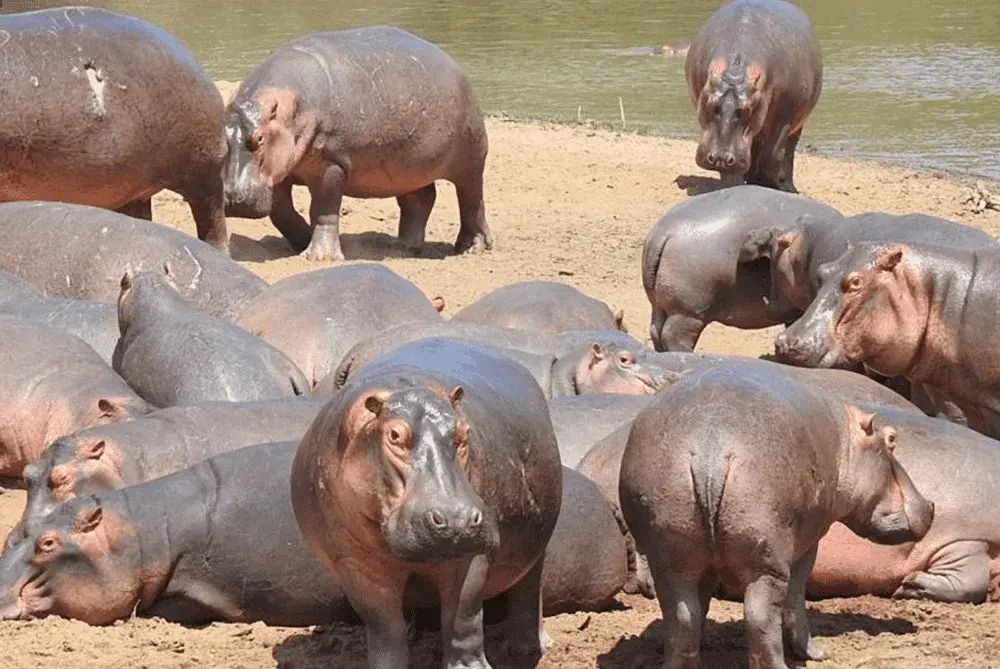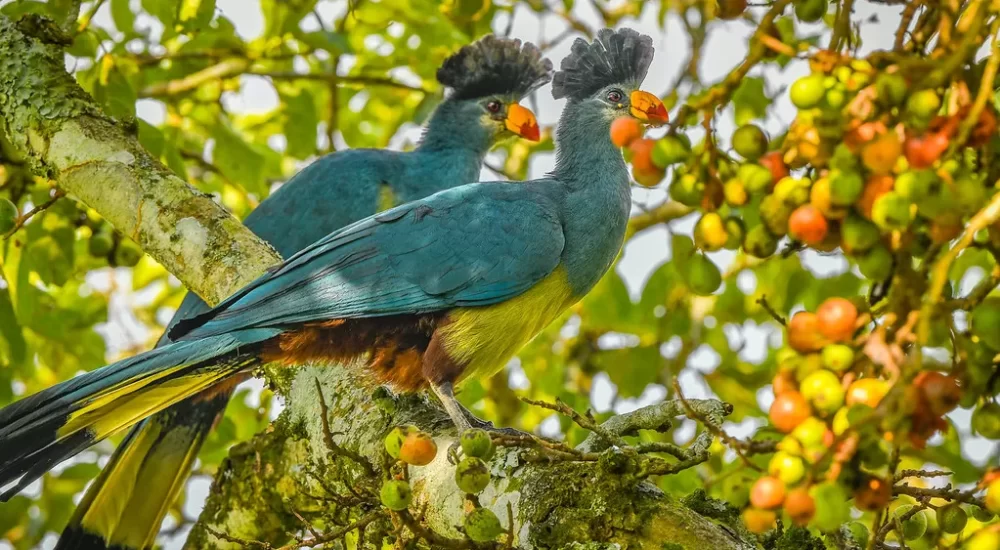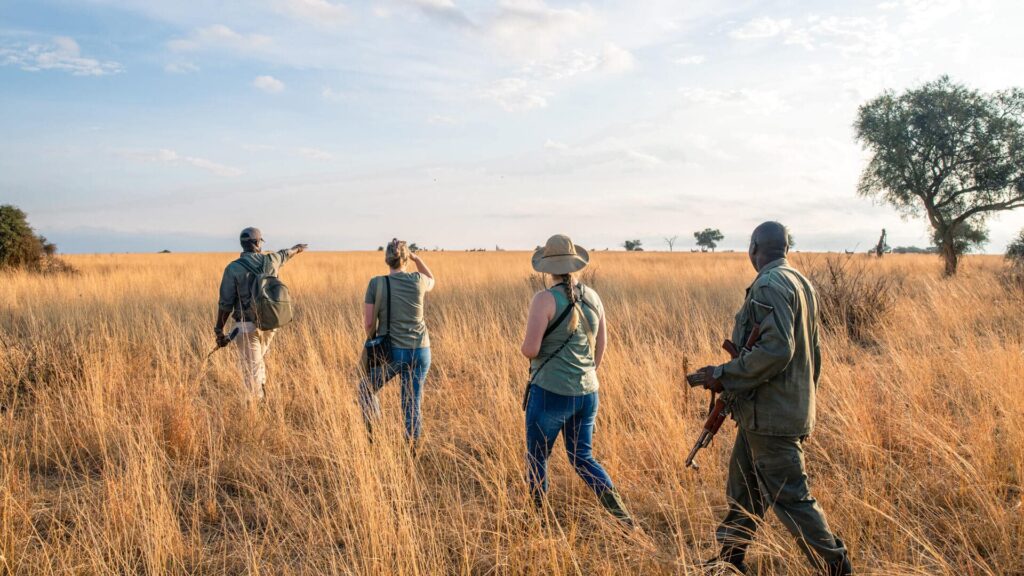Katavi National Park
Katavi National Park is a national park in Tanzania established in 1974. The park is situated in the Katavi Region and includes the Katuma River, as well as the seasonal Lake Katavi and Chada floodplains. It is a secluded park that receives less visitors compared to other national parks.
The park encompasses roughly 4,471 square meters, rendering it the third largest national park in Tanzania. Katavi possesses Tanzania’s highest density of crocodiles and hippos. Katavi’s lions and leopards encounter an abundance of prey, including impala, eland, topi, zebra, and large herds of buffalo traversing the short grass plains. With some fortune, one may also observe sable and roan antelopes. A diverse array of over 400 bird species flits among the trees, riverbanks, marshes, and palm groves, while groups of pelicans glide across the lakes.

Katavi genuinely flourishes during the dry season, when the floodwaters recede. The Katuma River, diminished to a murky stream, constitutes the sole source of potable water for miles. The most distinctive wildlife phenomenon in Katavi is its hippos. Near the conclusion of the dry season, as many as 200 individuals may congregate in any adequately deep riverine pool.
The park is readily accessible via charter flights provided by Zantas Air Services or Safari Air Link. The alternative is utilizing the road, which requires around 20 hours of driving, rendering it a challenging although remarkable adventure.
What Katavi National Park is Famous for
Wildlife Abundance
Katavi National Park hosts a varied array of species, including substantial herds of buffalo, elephants, giraffes, hippopotamuses, and crocodiles. The park’s distinctive terrain, with extensive grasslands, forests, and wetlands, offers a refuge for several animal species. Visitors may observe predators including lions, leopards, and cheetahs, alongside various antelope species such as impalas, kudus, and topis.
Birdwatcher’s Paradise
Katavi National Park is a haven for avian enthusiasts, boasting over 400 known bird species. Prominent avian species encompass the African fish eagle, martial eagle, and lilac-breasted roller. The park’s marshes and lakes host a diverse array of waterbirds, including as pelicans, storks, and egrets.

Isolated and Unreachable
Katavi National Park is among the most isolated national parks in Tanzania, rendering it an optimal locale for those desiring a more genuine and secluded wilderness encounter. The park’s secluded position results in lower visitor density compared to other national parks in Tanzania, offering guests a more tranquil and exclusive safari experience.
Importance of Culture
The Park is inhabited by the Katavi people, who have been in the region for centuries. Visitors can get knowledge of the local culture and traditions by exploring the adjacent villages and engaging with the residents. The park’s cultural importance is seen in its name, which originates from the Katavi language.
Attractions in Katavi National Park
Katavi National Park is a reservoir of great biodiversity, serving as an attraction and a primary cause for numerous visitors. During your visit to the park, there are many sights to behold, including:
Wildlife
Katavi Park is an unparalleled refuge for wildlife, supporting a diverse array of birds and mammals that draw numerous tourists for safaris.
Katavi National Park is a wildlife extravaganza that hosts a substantial population of animals, including over 4,000 elephants, more than 1,000 buffaloes, and a notable number of hippopotamuses and crocodiles, which are the primary attractions of the park. The park is home to zebras, antelopes, impalas, defassa waterbucks, giraffes, rare wildebeests, lions, and occasional hyenas and leopards. Katavi Park exhibits a significant concentration of wildlife in Lake Chada and Katavi, the two seasonal lakes situated within the floodplains that drain into the banks of the Katuma River.
Birds
Katavi National Park is a renowned avian destination in Tanzania, housing over 400 bird species that flourish in diverse vegetation, including marshy areas. The avian species residing in the park encompass the White-faced Whistling Duck, Egyptian Goose, Helmeted Guinea Fowl, Red-necked Spurfowl, White-browed Coucal, Grey Crowned Crane, Bare-faced Go-away-bird, Purple-crested Turaco, Marabou, Yellow-billed Stork, Saddle-bill Stork, Great White Pelican, Pink-backed Pelican, Hammerkop, Black-crowned Night Heron, Striated Heron, Cattle Egret, Goliath Heron, Little Egret, African Sacred Ibis, Hadada Ibis, among numerous others.
From November to April, Katavi National Park hosts migrating bird species.
Water bodies
Katavi National Park features picturesque water bodies that contribute to its dramatic landscape. The park is surrounded by two seasonal lakes, Lake Chada and Lake Katavi, as well as the Katuma River, which flows through the park. These aquatic bodies serve as the water sources for the park and its fauna.
Activities in Katavi National Park
Safari excursions
Katavi Park presents remarkable features, including spectacular vistas of wildlife, since it serves as a habitat for numerous animal species residing in significant concentrations. The park is home to buffaloes, giraffes, lions, defassa waterbucks, zebras, antelopes, hippopotamuses, crocodiles, wildebeests, and numerous more species. The game drive in the park traverses places such as the coasts of Lake Chada and Katavi, as well as the banks of the Katuma River, which are frequently populated by a significant concentration of wildlife, particularly during the dry season.
The optimal period for observing wildlife in Katavi Park is during the dry season, particularly in the middle and latter parts of this season, which spans from June to October.
Bird Watching
Katavi National Park provides an exceptional birdwatching experience for visitors, housing over 400 bird species, including a significant number of water-associated birds. Birdwatching in the park presents an opportunity to observe a diverse array of vibrant avian species, including the White-faced Whistling Duck, Egyptian Goose, Helmeted Guinea Fowl, Red-necked Spurfowl, White-browed Coucal, Grey Crowned Crane, Bare-faced Go-away-bird, Purple-crested Turaco, Marabou, Yellow-billed Stork, Saddle-billed Stork, Great White Pelican, Pink-backed Pelican, Hammerkop, Black-crowned Night Heron, Striated Heron, Cattle Egret, Goliath Heron, Little Egret, African Sacred Ibis, Hadada Ibis, African Darter, among others.
Birdwatching at Katavi Park occurs year-round; however, the optimal time for this activity is during the dry season, which spans from June to October. This period is marked by arid pathways, facilitating access to the park for bird observation. The optimal time for bird watching is from November to April, when migratory bird species from Europe inhabit the area.
Camping
Katavi National Park is an idyllic destination for nature enthusiasts and adventurous travelers, featuring numerous camping spots that allow visitors to experience the park’s picturesque landscapes overnight.
Nature Walks
Guided nature walks at Katavi National area provide exceptional experiences, allowing participants to traverse the area on foot while enjoying vistas of wildlife and avian species. You will also have the opportunity to explore exceptional wildlife watching locations, including Lake Chada, Katavi, and the Katuma River.

Accommodation options in Katavi National Park
Katavi National Park is a highly isolated national park with limited hotel options; the available facilities provide a comfortable stay for visitors. This comprises two seasonal luxury camps overlooking Lake Chada: Palahala Luxury Safari Camp and Riverside Camp Katavi, along with one rest house at Sitalike and various camping sites within the park, including Palahala River Camp, Katavi Wildlife Camp, and Chada Katavi Camp. The park features lodges such as Katuma Bush Lodge and Katavi Hippo Garden Lodge.
Best time for a safari in Katavi National Park
A visitor embarking on a safari in Tanzania can visit Katavi National Park at any time of day and throughout the year. However, individuals often seek to travel at optimal periods to enhance their experience, leading to many inquiries. The optimal time to visit Katavi National Park for a safari experience is during the dry season, specifically from May to October. The dry season is ideal because the park is relatively arid, and the receding floodwaters have diminished the katuma to a shallow, muddy trickle, which serves as the sole water source for the animals in the park. This location is where one may observe a concentration of animals, including buffalo, elephants, giraffes, and a group of hippopotamuses as they come to drink water.
Directions to Katavi National Park
Katavi National Park is situated in the southern area of Tanzania, within the Mpanda District, with its headquarters located 40 kilometers south of the town of Mpanda. The park is accessible via road, railway, and air transport. The park is located 1,236 kilometres from Dar es Salaam, 550 kilometres from Mbeya, and 390 kilometres from Kigoma by road. Traveling to the park by road is arduous, requiring a full day and a half of driving; therefore, utilizing railway or air transport is advisable. A train connects Dar es Salaam to Mpanda via Tabora; from Mpanda, one can obtain park transportation or rent a car to reach the park’s headquarters. Domestic charter flights to the park arrive at the Ikuu dirt airstrip, operated by airlines such as Safari Air Link and Mbali Mbali Safari Charter, managed by Zantas Air Services.

